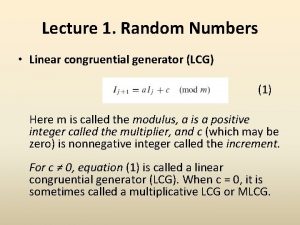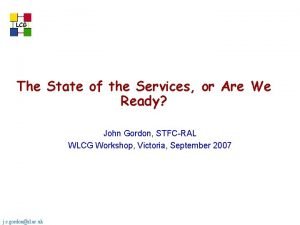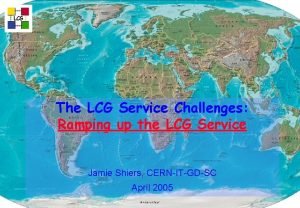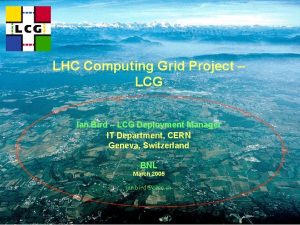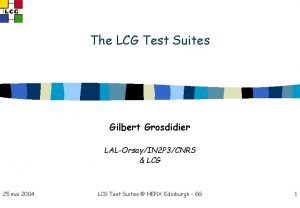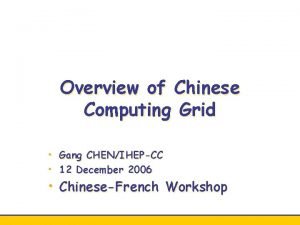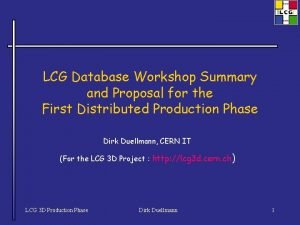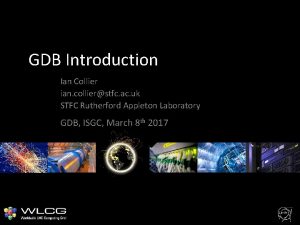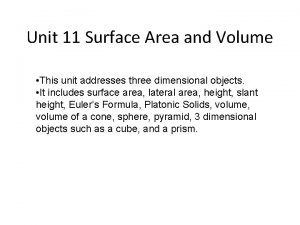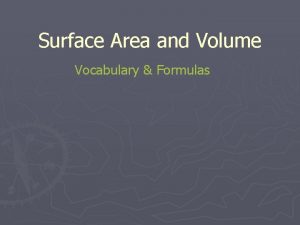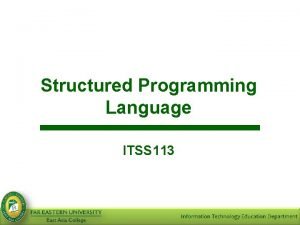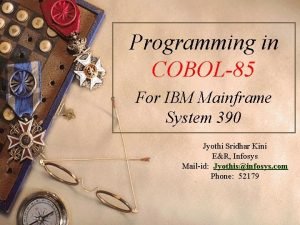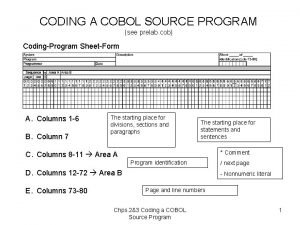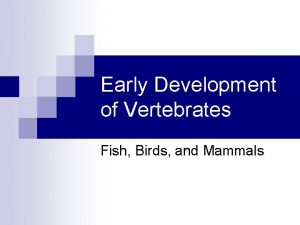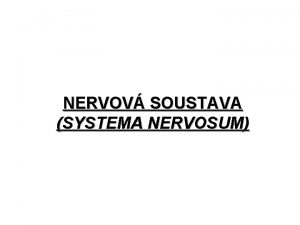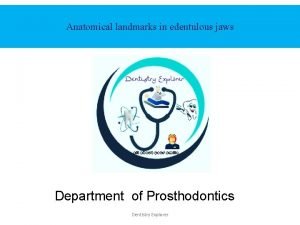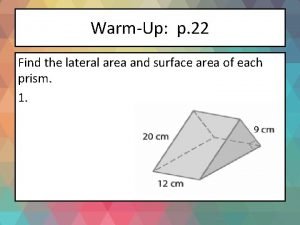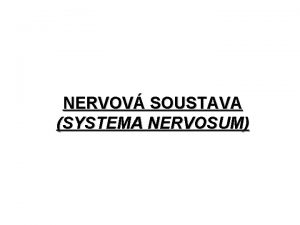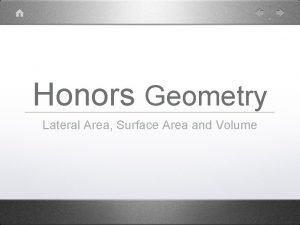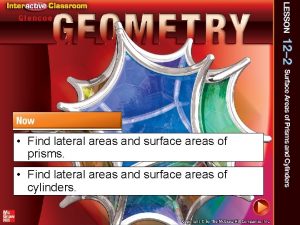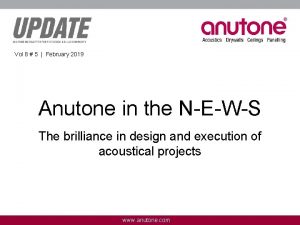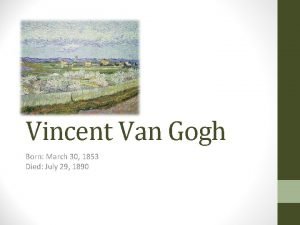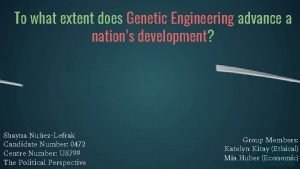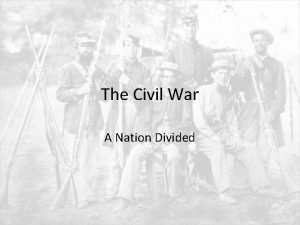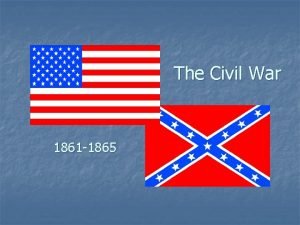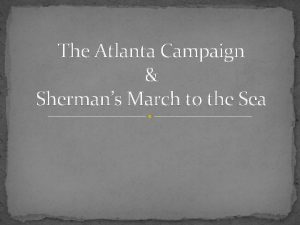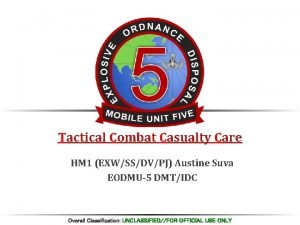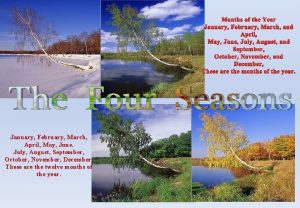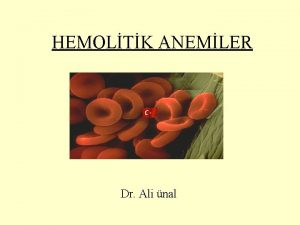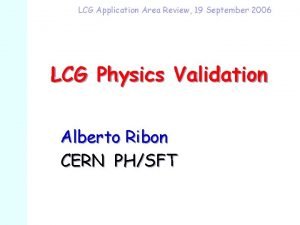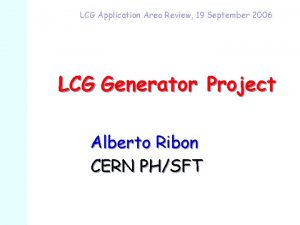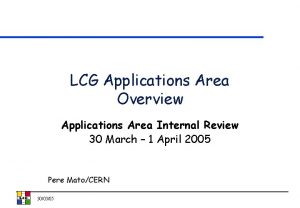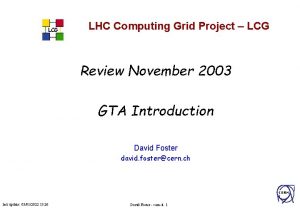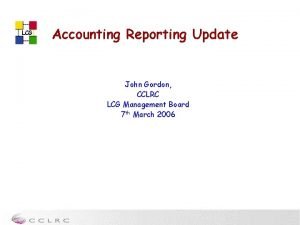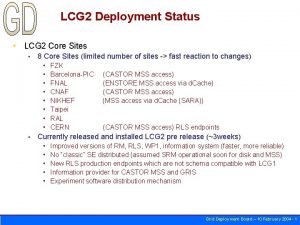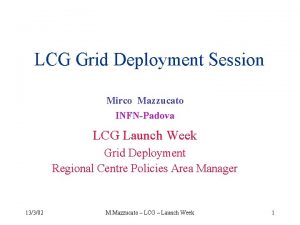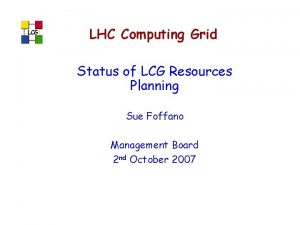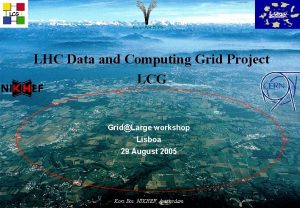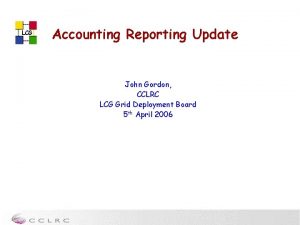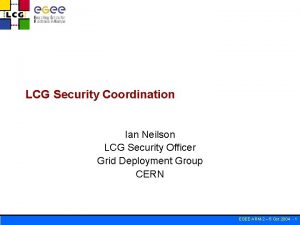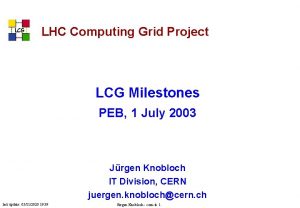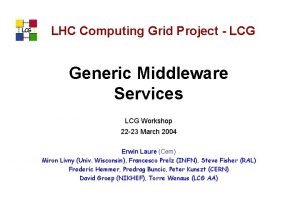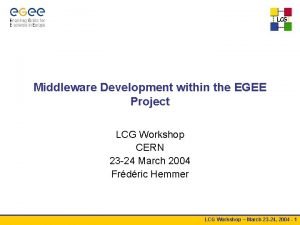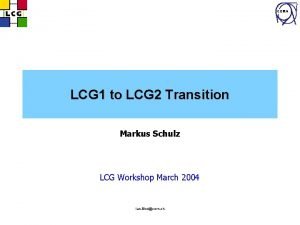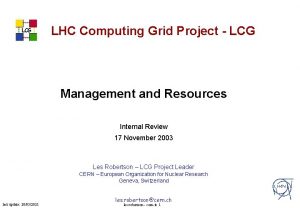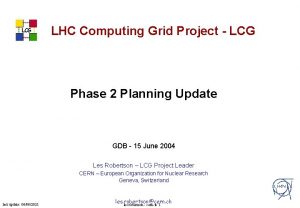LCG Application Area 2005 Review 31 March 2005

















































- Slides: 49

LCG Application Area 2005 Review, 31 March 2005 Physics Validation and recent development in Geant 4 and Fluka Alberto Ribon CERN PH/SFT

I part Physics Validation Alberto Ribon, CERN/PH/SFT 2

Outline • • Goals Strategy Results since the last review Work plan and resources For more information http: //lcgapp. cern. ch/project/simu/validation/ Alberto Ribon, CERN/PH/SFT 3

Project Goals • • • Compare Geant 4 and Fluka with the LHC test-beam data; Test coherence of results across experiments and sub -detector technologies; Study simple benchmarks relevant to LHC; “Certify” that simulation packages and framework are ok for LHC physics; Weaknesses and strengths of the packages. Alberto Ribon, CERN/PH/SFT 4

Strategy • As for the choice of the Geant 4 Physics List, the validation should be targeted to each considered application domain: e. g. for high-energy physics one should consider different observables than, for instance, medical physics, or space science. • The criteria to consider a simulation “good” or “bad” should be based on the particular application: e. g. , for LHC experiments, the main requirement is that the dominant systematic uncertainties for all physics analyses should not be due to the imperfect simulation. Alberto Ribon, CERN/PH/SFT 5

Validation project LHC physics simulation Does this meet LHC physics requirements (e. g. for compositeness) ? Suppose that e. g. for e/ : (G 4 -test-beam data)~10% Check with (fast ? ) simulations that this is good enough If not : Needs input/help from the experiment physics groups Alberto Ribon, CERN/PH/SFT 6

Validation setups Two main types of test-beam setups: 1. Calorimeters: the typical test-beams (made mainly for detector purposes). The observables are the convolution of many effects and interactions. In other words, one gets a macroscopic test. 2. Simple benchmarks: typical thin-target setups with simple geometry (made, very often, for validation purposes). It is possible to test at microscopic level a single interaction or effect. These two kinds of setups provide complementary information! Alberto Ribon, CERN/PH/SFT 7

Results • We consider here the main results on the Physics Validation project since the last review in October 2003 (about one year and a half). • Fabiola Gianotti has been the coordinator from the beginning of the project until September 2004. • First cycle of electromagnetic physics validation completed at the percent level. We will focus here only on the hadronic physics validation. Alberto Ribon, CERN/PH/SFT 8

Double-differential neutron production (p, xn) Juerg Beringer CERN-LCGAPP-2003 -18 Proton beam energies: 113, 256, 597, 800 Me. V Neutron detectors (TOF, scintillators) at 5 angles. Study of the neutron production spectrum (kinetic energy) at fixed angles. Alberto Ribon, CERN/PH/SFT 9

Pion absorption – experiments Witold Pokorski CERN-LCGAPP-2004 -11 n n K. Nakai at al. , PRL 44, 1446 (1980) D. Ashery et al, PR C 23, 2173 (1991) pi +/- beam monitoring counters thin target (Al, Cu, Au) Alberto Ribon, CERN/PH/SFT • Nakai – look for gammas emitted after pion absorption • Ashery – look for transmitted (not absorbed) pions detectors π± beams of energies between 23 – 315 Me. V 10

Absorption Xsection for π+ both G 4 and Fluka show reasonable agreement n in some cases Fluka seems to be a bit better n difficult to make more conclusions because of big uncertainties in the experimental data n Alberto Ribon, CERN/PH/SFT 11

Absorption Xsection for π- same remarks as for pi+ n for heavy material (Au) the shape of the QGSP_BERT quite different n G 4: best agreement for ‘medium-weight’ materials n Alberto Ribon, CERN/PH/SFT 12

Hadronic interactions in ATLAS pixel test-beam Alberto Ribon CERN-LCGAPP-2004 -09 180 Ge. V/c nominal + beam Geant 4 Geometry. Use the same Geometry also with Fluka, using FLUGG (interface between the Transportation and Physics of Fluka and Geant 4 Navigation of the Geometry). Alberto Ribon, CERN/PH/SFT 13

Number of reconstructed tracks Alberto Ribon, CERN/PH/SFT 14

Pseudorapidity distribution Alberto Ribon, CERN/PH/SFT 15

Ratio max Eloss / total Eloss QGSP is in excellent agreement with data. Alberto Ribon, CERN/PH/SFT 16

Cluster size QGSP produces too narrow clusters. FLUKA, LHEP and QGSC are in good agreement with data. In conclusion, FLUKA, Geant 4 are in reasonable good agreement with the data, but some observables can be improved. Alberto Ribon, CERN/PH/SFT 17

Calorimeter test-beams CMS HCAL & ECAL 1 17 ATLAS HEC h 7 8 7 6 Cr yst al 25 5 4 3 ATLAS Tile. Cal extended barrel module Alberto Ribon, CERN/PH/SFT f 0. 25 2 extended barrel 1 module η=0. 25 η=0. 65 19

energy resolution of pions 1. 2 1 0. 8 Alberto Ribon, CERN/PH/SFT 20

e/π ratio Alberto Ribon, CERN/PH/SFT 21

CMS longitudinal shower profile in HCAL for 100 Ge. V pions Alberto Ribon, CERN/PH/SFT 24

Radiation studies with Geant 4 Background radiation studies for LHC experiments have been done mainly with Fluka. It is very interesting to compare them with Geant 4, which offers a precise treatment of low energy neutrons with some Physics Lists like QGSP_BERT_HP. • Giuseppe Daquino (LCG) is working on radiation studies for LHCb: preliminary results have been already presented, and comparisons with Fluka will be ready by the end of April. • Pedro Arce (CMS) is working on similar radiation studies for CMS. Alberto Ribon, CERN/PH/SFT 25

Summary of the results • Monthly meetings, talks accessible from the Web page: http: //lcgapp. cern. ch/project/simu/validation/ • Presentations of results in various conferences (e. g. ACAT 03, IEEE-2003, CALOR-2004, CLHEP 04, etc. ) • Results documented in LCGAPP notes: ü J. Beringer, CERN-LCGAPP-2003 -18, “(p, xn) Production Cross Sections”. ü A. De Roeck et al, CERN-LCGAPP-2004 -02, “Simulation Physics Requirements from the LHC experiments”. ü A. Ribon, CERN-LCGAPP-2004 -09, “Validation of G 4 and Fluka Hadronic Physics with Pixels test-beam data”. ü F. Gianotti et al, CERN-LCGAPP-2004 -10, “G 4 Hadronic Physics Validation with LHC test-beam data: First Conclusions”. ü W. Pokorski, CERN-LCGAPP-2004 -11, “In-flight Pion Absorption: Second Benchmark Study for the Validation of Hadronic Physics Simulation”. Alberto Ribon, CERN/PH/SFT 26

Proposed work plan for 2005 • New LHC test-beam results (e. g. ATLAS combined; CMS): second half of the year; • Checks of the longitudinal shower shape with Geant 4 7. 0 : first half of the year; • Geant 4 background radiation studies for LHCb and CMS: first half of the year; • Simple benchmark test: inclusive charged pion production (multiplicity, y, p. T) in π±, K+, p, pbar interactions on Mg, Au, at 100 Ge. V/c : middle of the year; • Extension to Fluka for at least one calorimeter test-beam setup: second half of the year. Alberto Ribon, CERN/PH/SFT 27

Current LCG man power • G. Daquino : 75% F. T. E. dedicated to LHCb radiation studies with Geant 4. Leaving at the end of April. • M. Gallas : 75% F. T. E. dedicated mainly to ATLAS Combined Test-Beam, and some support for the ATLAS calorimeter test beam setups. • W. Pokorski : 30% F. T. E. dedicated to simple benchmarks, and extension to Fluka of the calorimeter test beam setups. • A. Ribon : 50% F. T. E. dedicated to coordination, simple benchmarks, and extension to Fluka of the calorimeter test beam setups. Alberto Ribon, CERN/PH/SFT 28

Possible work items beyond 2005 n n n Analysis of relevant LHC test-beams that have not yet been used for Physics Validation; New simple benchmark tests; Collection (e. g. database + Web interface) of data useful for detector simulation validation (similar to Jet. Web for Event Generators); Try to transform the LHC test-beam setups into stand-alone setups to be used for Geant 4 validation at each release; Systematic procedure for tunings/validation of simulation codes (both Event Generators and detector simulation engines). Alberto Ribon, CERN/PH/SFT 29

II part Geant 4 (transparancies provided by John Apostolakis ) Alberto Ribon, CERN/PH/SFT 31

Geant 4 in production n Three LHC experiments (ATLAS, CMS, LHCb) now using it successfully in production n OSCAR (CMS), Gauss (LHCb) and ATLAS’s G 4 -based simulation programs are the production tools. n n Substantial productions (numbers from Oct 20 th Aplic. Area meet. presentations) n n OSCAR and Gauss have replaced G 3 based simulation ATLAS DC 2 (summer 2004) produced 12 M events Oscar (CMS) : 35 M pp interaction events, and first 100 Pb-Pb events Gauss (LHCb): Over 200 M events simulated Production use demonstrated low crash rate (and decreasing with new releases) n Rate decreasing from 1/10 K events (5. 2, CMS) to 1 per Million events (6. 1, LHCb) – G 4 team addressed issues found in test productions n The Geant 4 LCG/SI sub-project and the Geant 4 Collaboration n n LCG/SI/G 4 responsible for CERN/LHC participation in Geant 4 Work plan integrated with overall Geant 4 plan n Geometry and tracking in field, Physics: hadronic and electromagnetic, testing and release, coordination Alberto Ribon, CERN/PH/SFT 32

Geant 4: some highlights n Geant 4 reliability in production: crash rate low and decreasing n CMS (Geant 4 5. 2, 1 crash per 10, 000 events) ATLAS (Geant 4 6. 0 patch 1, ~1 crash per 1 Million events) LHCb (Geant 4 6. 1, ~1 -2 crashes per 1 Million events) n Addressing issues found in LHC experiment production n Support and maintenance n n Code improvements to help identify problem conditions n n In hadronics and geometry (Geant 4, releases 6. 0 & 6. 1) Creation of ‘statistical testing’ suite n n Automated physics comparisons in simple test-beam-like setups Deployed for validation of release 7. 0 (December 2004) n n n Requires significant computer resources New and improved physics models n And improvements in EM & hadronics (Geant 4, releases 6. 1 & 6. 2) n E. g. enabling experiments to easily construct detectors, register volumes, . . Refinements & more functionality in kernel n n providing high job ‘robustness’ (less than ~1 per mille job failures in 6. 1, 6. 2) Reflections, divisions, … New fast shower capability (a-la GFLASH) n Integrating efforts in LHC experiments into Geant 4 toolkit n New addition, just scheduled for Geant 4, release 7. 0 Alberto Ribon, CERN/PH/SFT 34

Geant 4 Geometry n Abstraction of G 4 Navigator Also consolidation of the interface n New Divisions volumes (with P. Arce, CIEMAT) n for slicing volume, offers more options Replicas (including offsets) n n n Solids: n Review of ‘safety’ in Boolean & CSG solids n n Addressed issues from production, optics. n New twisted box & twisted trapezoid shapes n Added hook, called when one is created Volume Registration n G 4 Box, G 4 Tubs, G 4 Cons, G 4 Para, G 4 Trd, G 4 Polyhedra, G 4 Polycone Used in experiment framework (ATLAS) New abilities to compute volume, mass Propagation in field n Refinement of accuracy per field ‘manager’ Alberto Ribon, CERN/PH/SFT 36

Geant 4 Kernel n Design n revision of Run-Manager Modular for experiment use (thanks to M. Asai) n Eased maintenance & use in exp. frameworks n Better save/restore of physics tables n Can create & treat ‘unknown’ particles n Geant 4 to create tracks n n where physics is done already by event generator! Enables uniform treatment of track/trajectory Alberto Ribon, CERN/PH/SFT 37

Shower parameterization n. A shower parameterisation ‘a-la-GFLASH’ Implemented by members of ATLAS & CMS n Adapted & released first implementation n n Single n material part released in G 4 7. 0 Thanks to J. Weng, A. Barberio Future: sampling fractions for sampling calorimeters Alberto Ribon, CERN/PH/SFT 38

Standard EM physics n New “model-based” EM standard physics processes are now the default n model approach for energy loss and MSC we can more easily maintain and modify them to enable the easy use of different models for a single process (e. g. ionization) in one application previous user-interface unchanged n Speedup for low production threshold (‘cut’) values n n n Performance optimization for EM showers Improvements in high Energy processes (above 10 Te. V) : n Revision of muon Bremsstrahlung process Revision of muon ionisation and e+e- pair production n Roughly equivalent to drmat in Geant 3. 21 n n n New class to access for cross-sections and d. E/dx Revision of the Photo Absorption Ionization model Alberto Ribon, CERN/PH/SFT 39

Geant 4 Hadronic Physics n Binary cascade: Concluded inclusion of pion projectiles and light ion reactions n improved transition to pre-equilibrium model n Bertini Cascade: extended up to 10 Ge. V (thanks to A Heikinen) n n Scattering term n n New packages and models: n n n Abrasion/Ablation & EM dissociation for ions. Coherent elastic model for high energy elastic scattering. Cross sections: n Removed discontinuities in pion scattering data. Fix in high energy p-H cross-sections (G 3 legacy bug). n Optional kill primaries – can be steered from user code n n extended for nucleon induced reactions to 8 Ge. V included s-wave absorption pion induced reactions (up to 1. 5 Ge. V) Particle ID after interaction Alberto Ribon, CERN/PH/SFT 40

Geant 4 Hadronics ‘Infrastructure’ Recent improvements & extensions n Identify conditions leading to problems n n n Added biasing in framework n n n Retain information on reaction initial conditions On error, print it to provide information for users & developers cross-section biasing for e-/N and g/N leading particle Selection of target element n Choosing isotope centrally before calling ‘model’ n n Using approximate A 2/3 cross-section approximation Enables models to create appropriate final state Alberto Ribon, CERN/PH/SFT 41

Hadronic Physics Lists n The latest physics lists included since 6. 0 n 6. 0 ported from the best available in Dec 2003 n n Updates released as required (eg March, April 2004) n n Full validation against use cases undertaken 1 Q 2004 And incorporated in Geant 4 releases Physics lists and builders are used: n n As is, compiled in a ‘deployment’ directory Altered (or additional/customized version) by user/experiment, in own installation Alberto Ribon, CERN/PH/SFT 42

III part Fluka (transparancies provided by Alfredo Ferrari and Paola Sala) Alberto Ribon, CERN/PH/SFT 43

Fluka development framework • • • Regulated by the CERN-INFN Agreement (Dec. 2003, signed by CERN DG and approved by INFN Council) and by the Scientific Agreement of Feb. 2003 Scientific management by the authors (A. Fassò, A. Ferrari, J. Ranft, P. R. Sala) Overall supervision by Fluka Coordinating Committee (G. Battistoni (chairman), E. Chiaveri, J. Harvey, J. Ranft, P. R. Sala) Fluka: joint CERN-INFN copyright 1989 -2005 Authorship recognition and protection Confirmation that use of unauthorized versions infringes the copyright and will be dealt with accordingly Alberto Ribon, CERN/PH/SFT 44

Heavy ion development: examples • • Upgrade of high energy ionion generator to DPMJET-III Development and implementation of a model to describe Ion electromagnetic dissociation: critical for lead ion operation in LHC Coloured dots: experiments Full Histo: FLUKA Dashed: Elecromagnetic dissociation contribution Alberto Ribon, CERN/PH/SFT 45

Improvements to Evaporation and test of activation at CERF M. Brugger et al, Proc ICRS 10 Location of Samples: Behind a 50 cm long, 7 cm diameter copper target, centred with the beam axis Alberto Ribon, CERN/PH/SFT 46

Activation: example of results Alberto Ribon, CERN/PH/SFT 47

The Voxel Geometry Allowes complicated 3 -d voxel structures inside standard geometries. The first application: GOLEM (human phantom) for FLUKA application in space radiation and in therapy (data from Zankl and Wittmann 2001, GSF) from a CT “whole body” scan of an adult male of 68. 9 kg. 2. 2 million voxels, each is 2 x 2 x 8 mm 3 122 organs/tissues (8 different densities, composition taken from ICRU report no. 44) Alberto Ribon, CERN/PH/SFT 48

Another application of Voxel geometry in FLUKA Description of Gran Sasso mountain to build FLUKA transport of muons (E>1 Te. V) from VHE atmospheric showers down to the underground laboratory (ICARUS collaboration) Origin: local topographical map and geological survey Here: 1 voxel = 100 x 50 m 3 Alberto Ribon, CERN/PH/SFT 49

FLUGG • Upgrade to geometry in Geant 4 v 6 • New installation procedure ( from full FLUKA and Geant 4 distributions) • Application to ATLAS Pixel Alberto Ribon, CERN/PH/SFT 50

The 2 nd FLUKA Course Houston January 05 Special Course in Beijing Dec 04 Alberto Ribon, CERN/PH/SFT 51

Applications for LHC FLUKA- newly established team in AB department in charge of: • Beam heating calculations for LHC • Radiation damage calculations for LHC • Collimation system studies • CNGS radioprotection calculations • CNGS engineering calculations • Code development (CERN contribution) • 2 staff + 5 fellows +1 associate For recent studies/examples see the V. Vlachoudis presentation in http: //www. fluka. org Alberto Ribon, CERN/PH/SFT 52

n n n n IR 7 Simulations Dynamic FLUKA input generation from machine optics files Detailed description of about 20 prototypes Magnetic field maps: Analytic + 2 D Interpolated Prototypes are replicated, rotated and translated. Adjust the collimators planes during runtime! Dynamic generation of the ARC Optics test: Tracking up to 5 s, both vertical / horizontal, reproduce beta function Alberto Ribon, CERN/PH/SFT 53

A virtual tour in IR 7 Alberto Ribon, CERN/PH/SFT 54

The Cern to Gran Sasso n beam FLUKA simulation includes all details of beam transport, interaction, structure of target, horn focusing, decay, etc. Beam, engineering, radiation protection studies Neutrino event spectra at Gran Sasso available from CNGS web page : Alberto Ribon, CERN/PH/SFT 55
 Poland national anthem lyrics
Poland national anthem lyrics Lcg random
Lcg random Lcg
Lcg Lcg
Lcg Lcg projects
Lcg projects Lcg test
Lcg test Buaa vpn
Buaa vpn Lcg database
Lcg database Lcg webcast
Lcg webcast Chapter review motion part a vocabulary review answer key
Chapter review motion part a vocabulary review answer key Uncontrollable spending ap gov
Uncontrollable spending ap gov Nader amin-salehi
Nader amin-salehi Traditional and systematic review venn diagram
Traditional and systematic review venn diagram Narrative review vs systematic review
Narrative review vs systematic review Cisco waas vs riverbed
Cisco waas vs riverbed Unit 11 volume and surface area homework 4
Unit 11 volume and surface area homework 4 Surface area definition
Surface area definition Surface area and volume review
Surface area and volume review How to find the lateral area
How to find the lateral area Cobol area a and area b
Cobol area a and area b Cobol area a and area b
Cobol area a and area b Surface area of a cone
Surface area of a cone Lateral area def
Lateral area def Cobol cheat sheet
Cobol cheat sheet Anterior posterior axis
Anterior posterior axis Area radicularis
Area radicularis Surfce area
Surfce area Anatomical landmarks of maxilla
Anatomical landmarks of maxilla Lateral edge
Lateral edge Area radicularis
Area radicularis Systema nervosum periphericum
Systema nervosum periphericum Lateral
Lateral How to find lateral area of a prism
How to find lateral area of a prism Grihalakshmi magazine march 2019
Grihalakshmi magazine march 2019 Van gogh born
Van gogh born Source russia march
Source russia march March 1917 revolution
March 1917 revolution Sherman's march to sea map
Sherman's march to sea map Sherman's march significance
Sherman's march significance Path of sherman's march to the sea
Path of sherman's march to the sea Path of sherman's march to the sea
Path of sherman's march to the sea March algorthym
March algorthym American idol
American idol February and march season
February and march season Reasons why rizal lived in london
Reasons why rizal lived in london January february maruary
January february maruary Sherman's march to the sea
Sherman's march to the sea March 30 1981
March 30 1981 Proeritroblasto
Proeritroblasto 20 mile march
20 mile march

